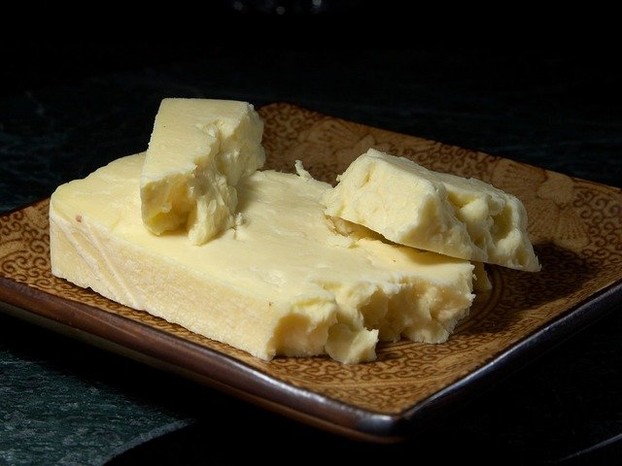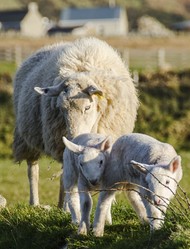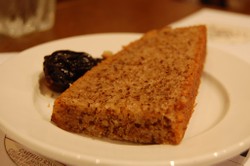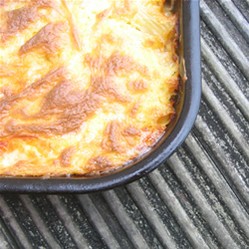Imagine the scene. The date is 1536 and the white-robed abbot speaks to the assembled valley folk. King Henry has looted the abbey of its wealth and evicted the monks, so the young abbot has no farewell gift for his tearful people. All he has left in the world is a recipe. He gives it to the valley folk facing impoverishment for loss of the work that the abbey provides. Then he bids them farewell and walks off, later to reluctantly join the Northern rebellion known as the Pilgrimage of Grace. For thus defying Henry Abbot Adam Sedbergh [Sedbar] was to be executed at Tyburn in London in 1537 by the gruesome method of being hung, drawn and quartered, a method too barbaric to describe on a family site.
This is the legend of Wensleydale. The scene is the product of my imagination; the legend is not. What truth lies in it cannot be ascertained, but oral history states that the departing monks gave the valley folk the recipe for Wensleydale cheese. The monks were Cistercians, an austere branch of the Benedictines who sought lonely places for their monasteries, like the valleys of Northern England, where they practised farming of sheep and cattle. The monks, who originally came from France, made a cheese of ewe's milk, which was popular and made them good profit. They made one change, moving from sheep's milk to cows'. This was because sheep only yield milk eight months a year, while the cheese business required the year round milk production that only cows could provide. Not that the valley folk could not make cheese already, they could, but they took over the monks' recipe and made their cheese in their own dairies and kitchens. And so they profited.
But by the later years of the nineteenth century things were becoming more difficult. International trade saw factory-produced cheese from America undercutting the craft cheeses made in British dairies. Moreover, cheap cheeses from Britain's imperial possessions, such as New Zealand, burst onto the market worsening the undercutting. Globalisation did no good at all for craft producers and traditional products.
War worsened matters, because under the appalling pressures of food shortages government standardised cheese production to a limited range of cheeses, the best known of which was known as government cheddar. After the Second World War supermarkets proved to be a force for standardisation, and production of local cheeses produced in small creameries declined. When I was a child in the 1950s I had only ever known cheddar cheese, which is not surprising, as rationing of cheese continued to1954; but I remember the day when my mother managed to get some Cheshire cheese! It was a novelty to me, and a delight.
However, the fightback by lovers of traditional, craft and farmhouse cheese lovers had already begun, and one name stands out, Kit Calvert and the Hawes creamery at the head of Wensleydale in North Yorkshire.










 Pilgrimage. A review22 days ago
Pilgrimage. A review22 days ago
 Leo the Fourteenthon 05/09/2025
Leo the Fourteenthon 05/09/2025
 The Melsonby Hoardon 03/25/2025
The Melsonby Hoardon 03/25/2025



Comments
No. The origins are cloaked in mystery. But the monastery of Jervaux was early second millennium, so any cheese making before that date wasnot monastic, so any cheese making before then would have been female, as the Saxon women were responsible for making food.9
The first paragraph in your introduction advises us that "We know that Wensleydale is a historic cheese, made for many centuries by the loving hands of craftswomen, for cheese was traditionally made by women. It was also made by monks of Jervaux Abbey, which was sited on the limestone hills of the area that we call the Yorkshire Dales."
Does any oral or written tradition indicate whether craftswomen or Jervaux Abbey monks initiated the first cheeses?
No. There are none. They are a ridge.
Thank you for your comment Nov. 24, 2020, in answer to my previous, same-day observations and question.
The name Cheviots makes me mull French origins.
But English Wikipedia presents Cheviots, in its The Cheviot article, as first rendered Chiuiet. That article suggests a Brittonic origin, from *ceμ- ("a ridge") and -ed ("having the quality of").
Would there be any local origin stories behind the place name Cheviots?
As Wensleydale is limestone country bogs are not common there, but in the Cheviots on the Scottish border there are many bogs.
This past week I found that the cheese section has the cranberry Wensleydale. I guess I didn't see it for the Irish cheeses. The cheese specialist indicated that it's a longtime favorite with many customers. The pure white is his preference even though as a berry lover he likes the cranberry Wensleydale. He said that Murray's requires a wax that is not on the cranberry Wensleydale in England.
What cranberry bogs where would Wensleydale use (probably not my favorites on this side of the pond in Massachusetts)?
It is made at Beechmount Farm, which covers 200 acres in the Golden Vale, which is an area of fine dairy country in Tipperary.
The farm now makes a sheep's milk cheese as well as Cashel Blue, the only sheep's milk cheese from Ireland. It is known as Crozier Blue. I have yet to sample it.
Cashal Blue is a big favourite of ours. I think it is from County Tipperary.
I once chewed on an Irish cheese, Kerry Farm, that was too hard. It is not now listed with Irish cheeses, so I infer that it has gone out of production. For Irish cheese, choose Cashel Blue. I have never tasted Cornish Yarg.
I love most cheeses . I can 't think of any i do not like except perhaps Cornish Yarg which matures wrapped in nettle leaves.